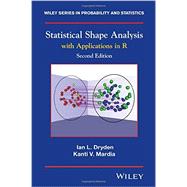A thoroughly revised and updated edition of this introduction to modern statistical methods for shape analysis
Shape analysis is an important tool in the many disciplines where objects are compared using geometrical features. Examples include comparing brain shape in schizophrenia; investigating protein molecules in bioinformatics; and describing growth of organisms in biology.
This book is a significant update of the highly-regarded Statistical Shape Analysis by the same authors. The new edition lays the foundations of landmark shape analysis, including geometrical concepts and statistical techniques, and extends to include analysis of curves, surfaces, images and other types of object data. Key definitions and concepts are discussed throughout, and the relative merits of different approaches are presented.
The authors have included substantial new material on recent statistical developments and offer numerous examples throughout the text. Concepts are introduced in an accessible manner, while retaining sufficient detail for more specialist statisticians to appreciate the challenges and opportunities of this new field. Computer code has been included for instructional use, along with exercises to enable readers to implement the applications themselves in R and to follow the key ideas by hands-on analysis.
- Offers a detailed yet accessible treatment of statistical methods for shape analysis
- Includes numerous examples and applications from many disciplines
- Provides R code for implementing the examples
- Covers a wide variety of recent developments in shape analysis
Shape Analysis, with Applications in R will offer a valuable introduction to this fast-moving research area for statisticians and other applied scientists working in diverse areas, including archaeology, bioinformatics, biology, chemistry, computer science, medicine, morphometics and image analysis.








